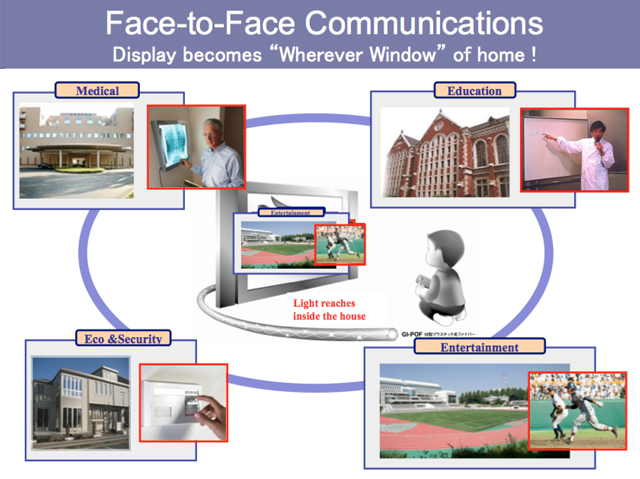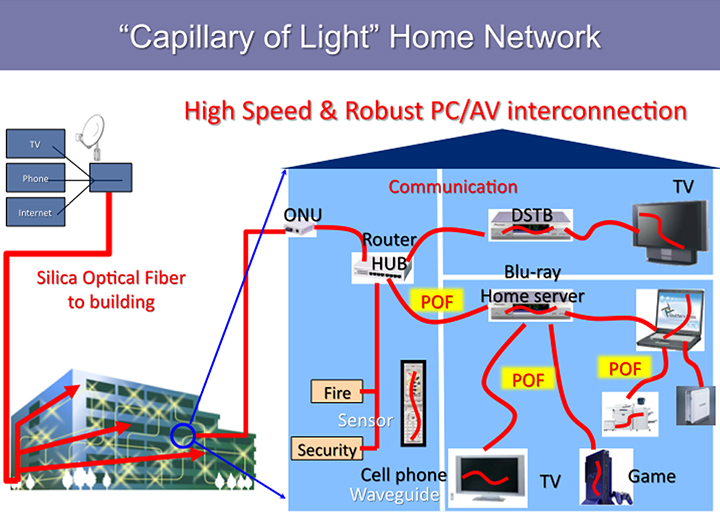Development of a Face-to-Face Communication System
We are aiming to create a new industry by combining the leading-edge photonics polymer material development results from sub-themes 1 and 2 as a total system, and pursuing the development and demonstration of face-to-face communication services through real images.
For this research theme, in order to transmit to the world a new concept for a safe and secure society, we are proposing a "face-to-face communication system" connecting individuals through "capillaries of light" comprised of GIPOF and a display which achieves a highly realistic sense of presence. Instead of using small diameter glass optical fiber, we utilize a high speed and large diameter GIPOF for information communication network extending until the terminal and a display that is comprehensively designed from the backlight to the LCD panel for a highly realistic sense of presence. It has the potential to create a completely new market compared to the one which has existed until now.
This total system was introduced into the Keio University Hospital in April 2012. It is capable of displaying stereoscopic displays--which are an important component of medical care--on a large screen at a wide viewing angle. Its formidable image reproducibility with very small color change and color irregularities is being highly appraised by medical-related parties. It is being applied in clinical treatment, and is beginning to be applied with great expectations in medical education, and this image reproduction effect is receiving a focus of attention among various medical congresses. In the future, there is great expectation for its development as a remote communications system to resolve regional differences in services in the medical and educational field, and in other areas.

Sub-theme 3 research themes are as follows:
"Development of ultra high speed, high resolution two-way image transmission technology"
 For example, we are developing high resolution image ultra high speed transmission technology enabling face-to-face communication with a realistic sense of presence which can connect the elderly living alone with remotely-located family members. In order to achieve real time transmission with high quality video and audio which is more natural and does not degrade, we are developing ultra high speed image transmission equipment, GI POF interface for ultra high speed image transmission, and ultra low-delay compressed transmission technology.
For example, we are developing high resolution image ultra high speed transmission technology enabling face-to-face communication with a realistic sense of presence which can connect the elderly living alone with remotely-located family members. In order to achieve real time transmission with high quality video and audio which is more natural and does not degrade, we are developing ultra high speed image transmission equipment, GI POF interface for ultra high speed image transmission, and ultra low-delay compressed transmission technology.
"Development of high speed and low cost household optical network"
In order to lay a nationwide high speed large capacity optical information communication network and to create a country which offers peace of mind by ensuring communications will not be interrupted even during disasters, the ideal scenario will be to connect an optical cable from outside the home directly to the display inside the home to replace inexpensive metal cables (UTP cables) which are thought to have practical limitations in terms of generating noise and heat as transmission speed increases. Collaborating with relevant makers such as telecommunications carriers and fiber makers, and connector makers, we are proceeding to develop GI POF interfaces for the home and Radio over Fiber (RoF) technology, with the aim of building "capillaries of light" through our unique optical interconnect which makes use of the advantages of the POF.
"Creation of a Face-to-Face communication industry"
The realization of face-to-face communications which transcends the concept of former communications technology is expected to bring about an innovative communication services environment which combines various information, and will be a motive force for generating new industry. This development will seek to clarify the relation between image parameters and visual effect in producing the formidable and realistic sense of presence from real time high resolution large screen images, and to create new industry from new values through the system design management method. And by obtaining feedback on the performance of the introduced system and by conducting verifications, we will continue to realize further advanced and effective applications.



